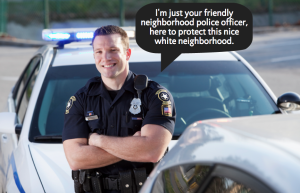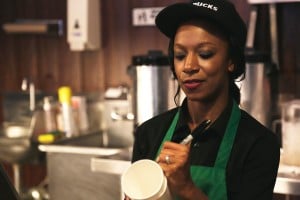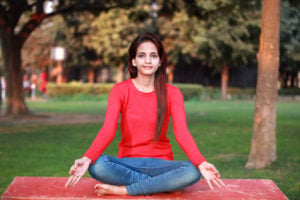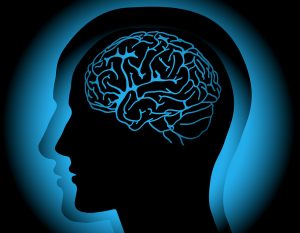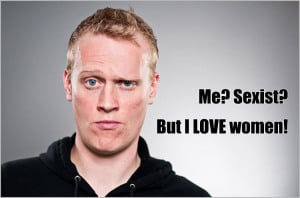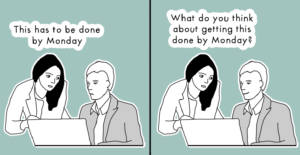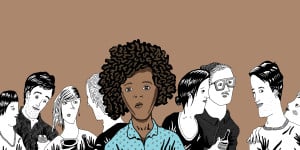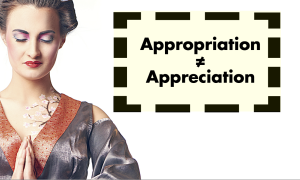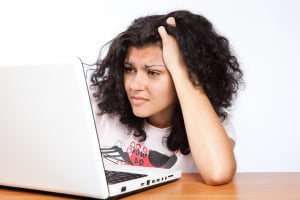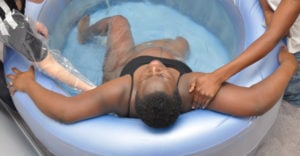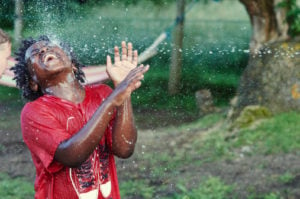Do you feel safe around police?
In the US, we’re pretty divided on the answer to this question. And unfortunately, the people who answer “yes” tend to have a lot more resources and privileges than those who say “no.”
So what’s influencing your answer? Is it personal experience, your class status, your neighborhood?
Your race?
Because chances are, if you’re a white person in the US, you feel safer around police than people of color do.
That’s because your white privilege helps protect you from many of the dangers police can pose.
And of course, even if you have white privilege, you can be oppressed in other ways. Classism, ableism, homophobia, transphobia, and other forms of oppression can create negative interactions with police for you, too. Your white privilege doesn’t erase your oppression.
But in this moment, activists are protesting a law enforcement system that upholds white supremacy and continues the violent legacy of slavery.
And many people still don’t understand why we say “Black Lives Matter,” or speak up about how Native people are most likely to die in confrontations with police, or protest profiling of Latinxs, or rally for Asian Americans and Arab Americans and all communities of color to unite in the fight against police violence.
Consequently, it’s crucial that we think about how privilege can make people of different races have different experiences with police, so that you, as a white ally, can understand why ending state violence is such an urgent need for communities of color.
So let’s look at some of these differences.
And as you read this, please understand that my goal is not to say that all cops are violent racists, but to show how the system of white supremacy creates traumatic, unsafe conditions for people of color.
Here are some examples of how white privilege can show up for white people when you’re interacting with police:
1. You Usually Have to Be Breaking the Law to Have the Police Called on You
Let’s start here, since people often dismiss protests against police brutality with one simple rule: “Don’t do anything wrong, and you won’t have to worry about getting hurt by cops.”
If you think that’s how it works, then I can see why you’re baffled about why we’re frustrated with law enforcement systems.
But that’s not how it actually works.
As verified law enforcement officers recently revealed in a Reddit thread about prejudiced 911 callers, people of color can have the police called on us for everything from “breaking into” your own house (with a key at the front door) to looking “out of place.”
Black teenager DeShawn Currie was accused of being out of place in his own home, by both neighbors who called 911 and the police who apprehended him when officers pointed to photos of his white foster siblings, mistook him for a burglar, and pepper-sprayed him.
Multiple studies show that implicit biases – which are thoughts you didn’t know you had – lead many Americans to see people of color as inherently dangerous.
So failure to stick to the rules isn’t the problem. Living in a society that calls for protection from Black and Brown bodies, whether they pose a threat or not, is what’s wrong.
2. You Usually Have to Be Breaking a Law to Have the Police Stop You
While it’s true that police officers can’t keep prejudiced citizens from calling them just because a person of color is in the vicinity, some cops and profiling practices also unfairly target people of color with no proof that they’ve done anything wrong.
When you’re driving, for instance, factors like speeding or drunk driving aren’t the only things that can get someone pulled over.
Race also makes a difference.
Studies reveal that in many places, like Chicago and New York City, people of color are far more likely to get pulled over – even though white people are more likely to be found with illegal substances or weapons. And people of color are less likely to be given a reason for why they were stopped.
Getting pulled over can be a terrifying situation for people of color, as the killing of Corey Kanosh, a member of the Kanosh band of the Paiute tribe, shows.
With the high rate of police killings of Native Americans, it’s no wonder that someone like Kanosh would have a fear of police – and the last moments of his life went from a call for help to a chase to his death.
The popular phrase “driving while Black” is a measurable risk, but as is driving while Latinx and driving while Native – which carries the greatest risk of all racial groups.
3. You’re Less Likely to Be Searched During a Stop
Even though white folks are more likely to have illegal materials in their cars, they run a lower risk of being arrested for those materials – because they’re less likely to be stopped and less likely to be searched if they are stopped.
Stereotypes drive the suspicion that people of color should be stopped and searched, but they don’t prove to be true.
In New York City, for instance, African-Americans are half as likely as whites to be found with a weapon and a third as likely to be found with contraband.
And still, Black drivers are three times as likely as white drivers to be searched when stopped.
Black NFL player Darnell Dockett – whose fame evidently doesn’t shield him from racial profiling – filmed and live-tweeted one of his police encounters in which an officer wanted to search his car, though he had no reason and gave no explanation for pulling Dockett over.
This harassment only makes us feel more unsafe around police, whether we’ve broken any laws or not.
4. You Have a Smaller Chance of Being Treated as a Suspect When You’re a Victim
Relying on police to keep us safe means we should be able to call them for help when we need it.
But you know those implicit biases that lead folks to see people of color as inherently dangerous? Those carry over even when people of color are the ones who need protection – and for us, calling the police, even when we’re victims, could be a matter of life or death.
Black homeowner Bryan Heyward learned that first-hand when he called the police for a burglary at his home, only to be shot by one of the officers who showed up.
Heyward was lucky enough to survive the shooting, but others have lost their lives to officers’ violent responses – like Jonathan Ferrell, who was killed when he sought help after a car accident.
People of color can’t confidently rely on the same safety system that white people can. If we do need help, we have to weigh the risks, because calling police might just make things much worse.
5. You Have a Greater Chance of Being Taken Seriously as a Victim
Doubt. Interrogation. Harassment. Arrest. These are things police officers have done when they respond to intimate partner violence in communities of color. But not just to abusers – to survivors.
This is just one of the ways victims of color struggle to be taken seriously as victims, leading us to not only be criminalized and treated as suspects, but also to have our calls to police go unanswered, our pleas for help ignored, even our murders uninvestigated.
Consider these alarming facts: Black women are incarcerated at four times the rate of white women. We’re more likely to be arrested for defending ourselves against violent partners. We’re the fastest growing prison population, and 75% of women in prison are domestic violence survivors.
And one last sobering number: Black women are three times more likely than other racial groups to be killed by a current or former partner.
Deanna Cook is one Black woman who tragically lost her life after her pleas for help went unanswered. The final moments of her life were recorded in her last of many 911 calls, and her family is speaking out about how her death shows the lethal impact when law enforcement systems fail to take intimate partner violence seriously in communities of color.
With the issue of IPV, problems with police show up across all racial groups, but survivors of color have to deal with an added racialized bias that gets in the way when we need help.
6. Class Makes a Difference in How You’re Treated
A lot of state violence targets people living in poverty – poor white folks and poor people of color alike.
But while white people with class privilege can escape this targeting, wealthy and middle class people of color still experience the same old story of being treated like a criminal.
In fact, wealthy Black folks may have to deal with more racial profiling, as they’re picked out for “looking like they don’t belong” in their upscale neighborhoods and suspected of being there to steal expensive cars and break into homes.
Rock star Lenny Kravitz, scholar Henry Louis Gates, and comedian Chris Rock are just a few celebrities who are rich, famous, and as Rock puts it, “still Black” – still being stopped by police for driving their own cars and entering their own homes.
Which makes their lives as wealthy Black people still markedly different from the lives of their wealthy white neighbors.
7. Your Pain Is Seen as Pain
Research shows that many people view Black folks as able to endure more pain than white people.
This racial empathy gap has real consequences, like prescribing fewer pain medications to Black people.
A lack of empathy for Black pain also leads people to cast a “superhuman bias” on Black people – including Black victims of police violence – viewing them as the stereotypical “magical Negro” trope.
For instance, police officer Darren Wilson’s testimony about Black teenager Michael Brown as a “demon” who charged at him through bullets was believable to many people, including members of a grand jury who decided not to indict Wilson.
If someone’s perceived as incapable of feeling pain, violence against them isn’t seen as a problem – it’s even seen as necessary for taking down any threat they may pose with all of their mythical “superhuman” strength.
8. Your Children Are Treated as Children
When the racial empathy gap is applied to children of color, it leads people, including police officers who hold racial biases, to see innocent Black kids as guilty adults.
In addition to seeing Black children as older and more guilty than their white peers, these officers are more likely to use force against Black youth.
It’s a terrifying situation for our children.
Consider how it turned out for twelve-year-old Tamir Rice, who was playing with a toy gun when police officers drove up and took one-and-a-half to two seconds to shoot him. When they called the station to report the shooting, they said Tamir was “maybe 20.”
They also watched him dying in agony without administering CPR. And handcuffed his 14-year-old sister when she ran to his aid.
These is a completely callous way to treat any child, but being treated as a child is a privilege that’s not afforded to Black children.
Parents of white children don’t have to tell them the police will treat their skin color as a threat, warn them about the dangers of showing anger (even if they’re mistreated), or answer the heartbreaking question of “Why am I a target?”
9. You’ll Get Less Time in Jail If You’re Arrested
One reason for people of color to fear the police is the fact that if we’re arrested and charged with a crime, we’re likely to face harsher punishments than we would if we were white.
The differences in the way we’re treated begin at the very start of our journey through the criminal justice system.
For African-Americans, for instance, we’re more likely to stay in prison awaiting a trial and most never get a trial. Then, once sentenced, Black men get prison sentences nearly 20% longer than white men sentenced for the same crime.
The reason most people sit in jail without a trial is absolutely infuriating: they simply can’t afford bail. This essentially sets up two different systems – one for the poor and one for the rich.
Studies show that those who can’t afford bail face tougher sentences and that Black folks have to pay a lot more to bail out. With limited options for defendants, “bail is used as ransom to extract a guilty plea.”
It’s scary enough to make a person of color afraid to turn themselves in, even if it’s “the right thing” to do.
For instance, when 18-year-old Allen Bullock’s parents encouraged him to turn himself in after he was photographed damaging a police car during the Baltimore protests sparked by Freddie Gray’s murder, they didn’t expect it to turn out like it did. Bullock was hit with a $500,000 bail – higher than that of the police officers charged with killing Freddie Gray – and he faces the possibility of life in prison.
Simply put, the criminal justice system doesn’t have the same measure of “justice” for all people.
When the difference between two crimes is the race of the person committing it, white privilege can save you on fines, probation time, and incarceration time.
10. You’re Less Likely to Get Arrested for Non-Violent Offenses
Knowing that our sentences will be harsher if arrested and charged is bad enough – add to that the fact that people of color are more likely to get arrested in the first place, and you can see how we take greater risks than white people when we interact with police.
Nothing makes this more clear than the War on Drugs – which, supposedly, keeps us all safe from dangerous drug users and dealers.
In reality, this war’s approach leads to a rate of arrest for Black people with non-violent drug offenses that’s ten times higher than the arrest rate of whites – even though white people use more drugs.
Thousands of people are serving life without parole for non-violent offenses – and 65% of those people are Black.
One of them is Bill Winters, a 54-year-old man whose record of non-violent offenses ended with taking Gobstopper candy from an unlocked oncologist’s office, for which he now serves the rest of his life in prison without the possibility of parole.
When weighing the risk of arrest and incarceration for a non-violent offense, white people have far less threatening numbers to consider.
11. You’re Less Likely to Be Killed for a Non-Violent Crime
Even if you overlook the racial disparities in arrests and sentencing, and even if you believe that the people who “do the crime” deserve to do prison time, we’re supposed to all have due process with a fair trial.
Instead, people of color are more likely to be killed as a result of coming into contact with police for a non-violent offense.
A Black man named Ervin Leon Edwards was tasered to death after being taken into police custody for sagging pants. His girlfriend begged police not to use their stun guns on him because of his high blood pressure. Between her pleas, his partial deafness, and his mental disability, you have to wonder why this man arrested for a non-violent crime was tased in the first place – and so severely that it led to his death.
In addition to disability and mental health, factors such as age and language barriers should mean that police take extra care with the citizens they approach – but in cases like the beating of 84-year-old Chinese man Kang Wong, who was stopped for jay-walking, those factors make people of color less safe around police. Fortunately, Wong survived the beating – but the fact that violence was used against him in the first place is outrageous.
A non-violent offense should not be punished with an immediate death sentence, but for people of color, it’s more likely that it will.
12. You’re Less Likely to Be Killed for a Violent Crime
It’s so ironic that police often say they “had” to kill someone to eliminate a violent threat, when they’ve already demonstrated that it’s possible in many cases to do that without killing anybody.
And a white person has a greater chance of being taken in alive.
Yuvette Henderson, a Black woman in Emeryville, CA, was not given that chance. Police say she was holding a gun, though activists dispute that claim, and neither party’s account says that Henderson ever pointed a weapon at officers. Whatever the truth was, it ended with police killing her with a military-grade, automatic AR-15 rifle.
Could police have avoided her violent death? I can’t speak for them, of course, but I can point out that just two weeks earlier and half a block away, a white man named Sebastian Ledwick opened fire on officers, who arrested him without killing him.
Countless examples show violent white people being apprehended by police and living to face their trials.
For people of color, even a “suspicion” of violence can end in our deaths – and then it’s harder for us to see justice as victims.
13. You Don’t Have to Fear Being Killed by Police Even If You Do Nothing Wrong
The terrifying truth is, we don’t even have to talk about whether people of color are committing violent or non-violent crimes when they’re killed by police, because we’re also more likely to be killed by police for doing absolutely nothing wrong.
The ways police target our neighborhoods, stereotype us as criminals, and see us as inherently dangerous combine to put people of color simply living their lives at risk of being killed by police.
Black Marine Sergeant Manuel Loggins, Jr. was getting into his car, where his nine- and fourteen-year-old daughters were sitting, when a sheriff’s deputy who “feared for the safety” of the girls shot and killed him.
Akai Gurley was coming home to one of New York City’s public housing developments, where officers do “vertical patrols” sweeping hallways and stairwells with guns drawn. Officer Peter Liang was doing just that when he shot Gurley in a staircase, then went back downstairs instead of offering him medical aid.
Gurley was killed just for coming home and Loggins, for picking up his daughters.
These are everyday activities white people can engage in without being profiled as a violent criminal and executed.
14. You’re Less Likely to Be Stopped or Killed Because You ‘Fit the Profile’
So if people of color can be stopped or killed by police without doing anything wrong, what is the deciding factor that puts us in contact with police so often?
As Jezebel Delilah X writes, “These officers are rarely from the communities they patrol, and they’re more likely to utilize stereotyping and racial profiling to identify potential criminals.”
Breaking down the numbers for New York City’s Stop-and-Frisk policy, it’s clear how often race determines who gets stopped. In 2013, nearly nine out of ten of those stopped under the policy were Black or Latinx – and about 90% were innocent.
Innocence makes no difference in these tactics of policing, as Miami resident Earl Sampson can confirm. Sampson was stopped by police a whopping 258 times over the course of four years, most frequently being accused of or arrested for trespassing at the store where he works.
The idea behind such policing is that it’ll get criminals off the streets.
The reality is that it’s legal racial profiling, harassment of innocent people of color, and just one more factor that leads people of color to feel unsafe around police.
15. You’re Protected by Self-Defense Laws
Laws like Stand Your Ground and Open Carry are supposed to give citizens the right to protect themselves.
But people of color don’t actually have the freedom to exercise those rights without being treated like criminals.
In fact, the record shows that Stand Your Ground harms people of color, with white-on-black homicides more likely to be ruled justified than white-on-white ones by a staggering 354%.
It’s a different story when Black people have guns in their hands.
Marissa Alexander‘s Stand Your Ground defense was unsuccessful in court, resulting in prison time for firing a warning shot to ward off her abusive husband. John Crawford was holding an air rifle used to shoot pellets or BBs in the Wal-Mart where it was sold when police saw him as a threat and killed him.
Meanwhile, groups of white people get to exercise their right to brazenly carry fire arms, with Open Carry laws – and white privilege – to protect them.
16. You or Your Children Are More Likely to Be Treated as a ‘Good Kid Who Made a Mistake’
Many people have stories of being reckless teenagers, or even reckless adults, who might’ve ended up serving time in jail if things had gone just a little differently.
For the people who added their stories to the hashtags #CrimingWhileWhite and #AliveWhileBlack, the difference was in the color of their skin.
The hashtags showed the double standard that can let white people off the hook for behavior that people of color would be arrested – or even killed – for, and have people of color getting harassed for no crime at all.
These examples show police treating young white people as harmless “kids being kids,” while young people of color are more likely to get arrested and to serve adult sentences for their crimes.
Take the recent police attack on a group of youth of color in McKinney, TX. Video shows that young people of various races were present, but the police left all but one of the white kids alone while they physically subdued the other kids, body-slammed bikini-clad Black teenager Dajerria Becton, and pointed a gun at her Black friends.
Meanwhile, the white 15-year-old boy who filmed the video recognized race as the deciding factor in the way the kids were treated, saying, “It was kind of like I was invisible.”
Young people of color are also more likely to face harsher punishments in school, more suspensions, and more incidents in which police, not principals or parents, are called to deal with them.
17. You Can Call 911 for a Medical Emergency without Fear of Police
Quick: What do you do if someone in your home is having a heart attack? Call 911? That’s an easy answer, right?
Well, if you’re in a community full of people of color, it might not be so easy.
For instance, as local police departments have become more involved in federal immigration matters, more and more Latinxs – regardless of their immigration status – have had negative interactions with police that contribute to their choice not to call an ambulance in cases of cardiac arrest.
Their understandable distrust of police also keeps many Latinxs from calling the police for help when they’re victims of a crime.
Calling for help with a family member’s mental health crisis can also bring danger, as the parents of 18-year-old Yanira Serrano found out when police officers answering their call shot and killed their daughter within 20 seconds of arrival.
With communities of color and poor communities already lacking the health services they need, the risks of calling 911 creates yet another obstacle to our well-being.
18. You’re Less Likely to Live in a Community Traumatized by Police Brutality and Mass Incarceration
Deciding not to call 911 for a medical emergency clearly comes with a health risk.
But even living in a community targeted by police can have a negative impact on a person’s health.
Researchers studied communities of color where children are treated as criminals from a young age, and high incarceration rates create instability for families, employment, and housing.
They found that the impact of criminalization is similar to a “plague,” causing high rates of depression, anxiety, and infectious diseases.
Incidents of police brutality also hurt public health, leaving lasting trauma for people who have survived police violence, families of those killed by police, and community members living in neighborhoods where victims are killed.
Tamir Rice’s mother, Samaria Rice, has been living with this trauma and she temporarily moved into a homeless shelter because she could no longer live next to the place where Tamir was killed. And she had to endure all of this while grieving his loss and being denied the chance to bury her young son.
And because police target communities of color, the physical and mental toll weighs on these communities the most.
19. You’re Less Likely to Have to Choose Between Risking Arrest and Not Surviving
So after carrying all these risks that give a person of color a higher chance of getting locked up, surviving after incarceration is even more difficult.
This brings us back to another answer to the idea that we should just obey the law to avoid police: There’s not exactly an abundance of options for a formerly incarcerated person, especially a person of color, to get on a straight and narrow path and support themselves while staying out of trouble.
Some lucky people do.
But there are many obstacles to overcome, including healing from the trauma of incarceration and finding employment with a criminal record.
One study found that white job applicants with criminal records were called back from employers more often than Black applicants with criminal records – and race was such a factor that white people with criminal records were treated even better than Black people without them.
Danny Murillo can be called a success story – he spent 14 years in prison, including six in solitary confinement, before attending UC Berkeley. But hear about the “employment barriers, psychological trauma and social stigma” that he faced at every turn, and you’ll understand why his story also includes advocating for the rights of current and former prisoners who face the nearly impossible task of re-integrating into society.
It’s a vicious cycle of structural barriers: returning to communities that have high rates of poverty and unemployment to begin with, just to be shut out of jobs by stigma and racial bias, and risk re-arrest if they turn to survival tactics that break laws.
And all the while, still being profiled and targeted by police, whether they’re “staying out of trouble” or not.
20. You Can Feel Reassured Knowing There are ‘Good Cops’ Who Aren’t Racist
We all also know stories of police officers being peaceful, risking their lives for others, and just being decent human beings who aren’t violently racist. So hearing that good cops also exist among “a few bad apples” is reassuring, right?
Maybe if you’re a white person who wouldn’t risk losing your life if you happened to come across one of those racist bad apples.
For people of color who adopt “fear as a way of life” to survive the dangers of police harassment and brutality, knowing that some cops are good doesn’t erase the terrifying reality that the system of white supremacy is alive and well in law enforcement.
The last time I was pulled over, I was driving with my partner to a Black Lives Matter panel in San Francisco’s Mission District. It was at the height of the Freddie Gray protests in Baltimore.
I had no reason to assume the officers pulling me over for a broken brake light weren’t two of the “good cops.” But how could I know?
How could I be sure they weren’t like the SFPD officers who were caught sending racist text messages, or like South Carolina officer Michael Slager, who’d shoot a man in the back and lie about it? How could I even know that they weren’t “good cops” who would uphold the racist system they’re working in, even without meaning to?
I came away from the stop with a fix-it ticket – no search, no arrest, no brutality. This experience can reassure me that there are, indeed, cops who won’t necessarily mistreat me because of my race.
But I still know that many other people just like me have not been so lucky.
Other people of color can say the same. And our family members, friends, and neighbors who were killed by police aren’t alive to tell us how to recognize which officers will kill you.
***
If you’re a white person, then in many circles you also hold the privilege of having people who ignore voices of color listen to your voice instead. So use your privilege for good and speak up when you can.
And whenever you can, center the leadership of the powerful people of color leading movements against state violence. There’s a flood of voices out there, sharing moving stories and building alternatives to our corrupt law enforcement system.
I’m a Black woman, so I’m addressing this issue from my perspective, but there are so many others speaking up for Native lives, Latinx lives, and more.
And we all deserve to feel safe. Let’s work together to stand against the police violence and criminal injustice that makes safety impossible for so many of us.
[do_widget id=’text-101′]
Maisha Z. Johnson is the Digital Content Associate and Staff Writer of Everyday Feminism. You can find her writing at the intersections and shamelessly indulging in her obsession with pop culture around the web. Maisha’s past work includes Community United Against Violence (CUAV), the nation’s oldest LGBTQ anti-violence organization, and Fired Up!, a program of California Coalition for Women Prisoners. Through her own project, Inkblot Arts, Maisha taps into the creative arts and digital media to amplify the voices of those often silenced. Like her on Facebook or follow her on Twitter @mzjwords.
Search our 3000+ articles!
Read our articles about:
Our online racial justice training
Used by hundreds of universities, non-profits, and businesses.
Click to learn more


